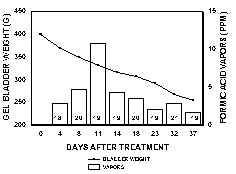Evaluation of New Treatments for Parasitic Mites of Honey Bees
2000 Vegetable Initiative Report
J. A. Skinner, J. P. Parkman & M. D. Studer
Studies conducted in research apiaries at the Plant Sciences Farm help to evaluate the efficacy of promising honey bee parasitic mite control materials. A fall 1999 trial assessed Apilife VAR, a European product containing the botanical oils thymol (76%), eucalyptus (16%), menthol (4%), and camphor (4%), for management of Varroa and tracheal mites. Checkmite+, coumaphos-impregnated strips registered for Varroa control, was included as a comparison. In spring 2000, we evaluated a new delivery method for formic acid gel for Varroa and tracheal mite control: a sealed, latex "bladder" containing 200 g of 65% formic acid gel. This was compared to Apistan, the most popular Varroa control product.
During fall 1999, Apilife and Checkmite+ were applied and kept on colonies for 42 days. After treatment removal, Apistan was placed in colonies for 21 days to detect Varroa survival and determine percent control. Varroa abundance was monitored continuously with sticky board traps and pre- and post-treatment estimates of amounts of bees, brood and food stores were made. Due to weakness of several colonies, post-treatment bee samples, used to determine tracheal mite incidence, were not made; thus, efficacy of Apilife against tracheal mites was not determined. In spring 2000, formic acid bladders and Checkmite+ were applied for 37 days. Varroa abundance was monitored, bees were sampled to determine tracheal mite incidence, hives were weighed to determine honey production and honey samples were collected after treatment to detect formic acid residues.
In fall 1999, Checkmite+ and Apilife provided 95 and 79% control, respectively, of Varroa. There was fewer brood in all colonies after treatment (reduction in brood is normal for this time of year), but only Apilife-treated colonies had fewer bees. Food stores in all colonies remained unchanged after treatment (see figure). During the spring 2000 evaluation, temperatures were too cool to allow for sufficient evaporation of formic acid to produce vapor concentrations great enough to cause Varroa mortality (see figure). Evaporation of 7-10 grams of formic gel per day is required to kill Varroa. Formic acid residues were detected in honey samples from hives treated with the bladders, but levels were below tolerances allowed by the FDA. Honey production, based on colony weights, was not affected by bladder treatments. Tracheal mite samples are still being examined.
Apilife, which can provide adequate Varroa control, is likely to become registered for use in the USA within the next year. When used in combination with other management tools, such as open bottom boards, it can provide control similar to that of Apistan. Apilife can also reduce tracheal mite numbers. The formic acid bladder is an experimental delivery system developed recently in Canada. The bladder may offer a warm-weather alternative to Apicure gel packs, the only formic acid product available in the USA, which desiccates rapidly at warmer temperatures (> 80E F ambient), thus reducing its efficacy. Based on our fall 2000 evaluation, the bladder appears to release adequate amounts of formic acid vapor for long periods of time at ambient temperatures between 80 and 90E F.


Left: Mean amounts of honey bees, brood (immature bees), honey and pollen stores found in colonies before and after treatment with Apilife VAR and Checkmite+ and in untreated colonies, fall 1999. Amounts were estimated as proportions of hive frames. Asterisks denote pairs of means found significantly different by t-test, P<0.05.
Right: Mean weight of formic acid gel bladder treatments and mean formic acid vapor concentrations detected in treated colonies, spring 2000. Numbers within bars are the mean ambient temperature (EC) for the days vapor concentration readings were taken.